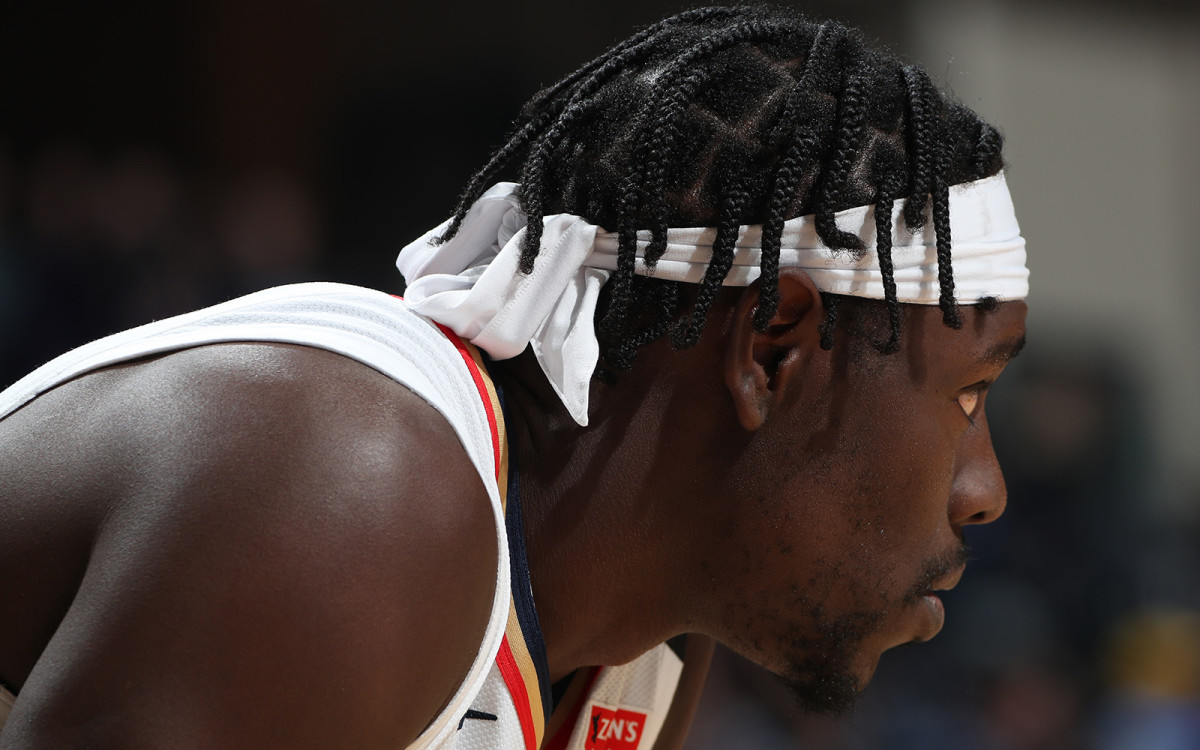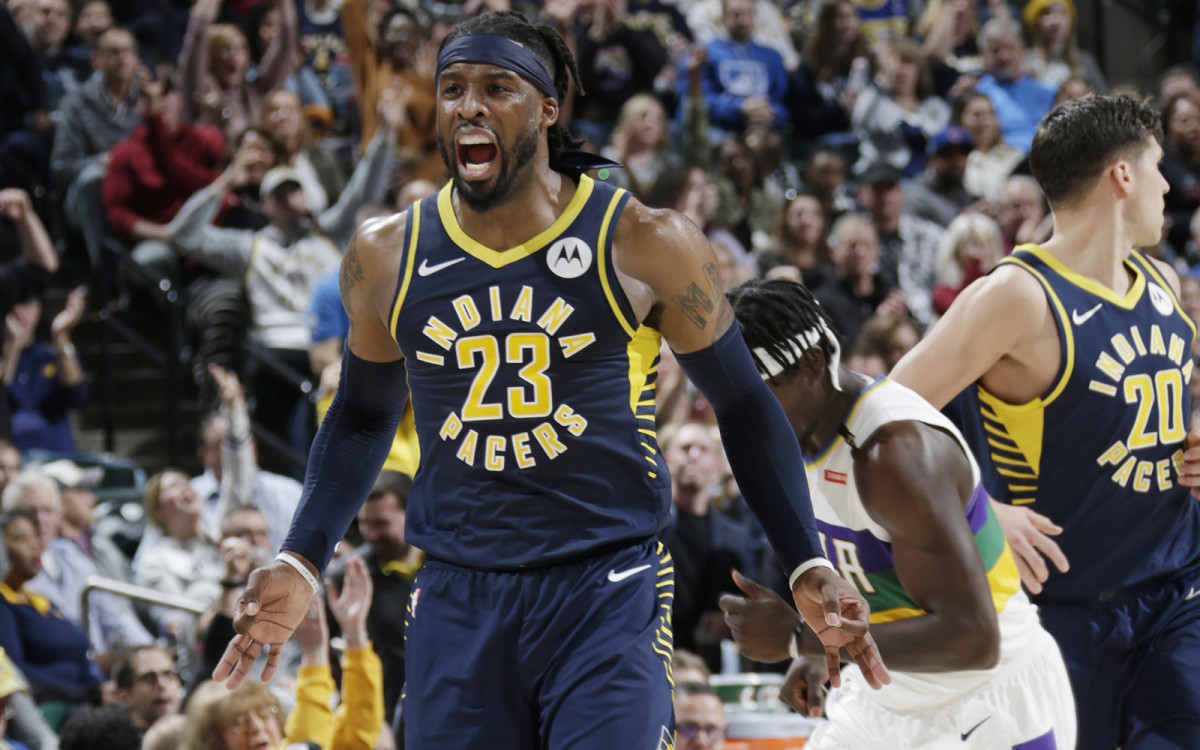Sweep the League: How 'Karate Kid' Headbands Became an NBA Style Staple

Klay Thompson arrived at Oracle Arena on Halloween night decked in a complete Jackie Moon uniform, spinning a red, white and blue basketball on his index finger to wholly depict Will Ferrell’s iconic character from Semi-Pro. Warriors forward Alfonzo McKinnie strolled into the stadium draped in a full-body Deadpool costume. Golden State’s wings shed their ensembles before the Warriors and Pelicans tipped off that evening, although New Orleans guard Jrue Holiday took the floor wearing a bit of a costume himself: a black, karate-style headband, the loose ends dangling below its tie in the back. Since that night, #KungFuJrue has been trending on Twitter all season.
Holiday’s unique headband-style has permeated the league this season. “They call me Karate Kid, Ninja Turtle,” says Pacers guard Wes Matthews, who also dons the NikeCourt Dri-FIT 2.0, tie-back headbands. According to the NBA’s outfitting group, several teams contacted the league at the start of the 2018-19 season, seeking permission for players to wear the headbands. The NBA requires that, during games and practices, players wear headbands no wider than 2.5 inches and must be entirely white, entirely black or within team color assortment. They must also feature the NBA logo. The tie-back headbands have been permitted as they fall within the width and color guidelines. They don’t currently feature the NBA logo, but Nike and the league are collaborating to produce the product by early March.
The style has become popular in tennis as Nike and its equipment suppliers created a retail version of the headbands that Roger Federer and Rafael Nadal have so famously worn in majors across the globe. Based on feedback from NCAA women’s athletes, the trend was next adopted by female high school and college athletes primarily playing volleyball, basketball, lacrosse and softball. Nike says NBA players’ widespread affinity for the apparel began roughly nine months ago. “I’m a Nadal fan,” Holiday says. “I’ve been wearing it in the summers for three years now.” As the guard experimented with growing his hair into twisting braids, Holiday would rotate between white and black tie-back headbands during his offseason workouts, replacing his typical durag. As he opened the 2018-19 season, Holiday, having long boasted a closely-trimmed cut, hoped to further accentuate his more voluminous style on-court this winter. “Fashion statement all the way,” he says. “It’s a style choice,” adds Celtics All-Star Kyrie Irving, who wore a tie-less version of the thicker band at the onset of the season. "Just like my hair."

Indiana center Myles Turner developed a “samurai” look this season—a nickname both Pacers teammates and fans have fully embraced—using a headband to complement his new pony tail. The effect was most recently culminated by sporting a mask after he broke his nose in January. Turner saw the tie-back headband being worn around the league and pleaded with Indiana’s training staff to order a few for him. He now rotates through six different bands, while still mixing in the traditional sweatband. “It’s lighter. I feel like a kid again. It’s just fun and I think it looks better,” Turner says. “I’ve had some of my best games I’ve worn it. Double-doubles every time, so it can’t be that bad.” However, Holiday’s younger brother, and Turner’s Indiana teammate, Aaron Holiday, isn’t as convinced the tennis look truly impacts player performance. “That’s a tough one,” he chimed. Turner, a stall over in the Pacers’ pregame locker room, countered the rookie just, “is not into conspiracies.”
A month before he was dealt from the Mavericks to the Knicks, Matthews felt he needed to add a spark to his game. After consistently wearing bandanas and durags during his own summer workouts, the sharpshooter hoped to infuse some joy into the doldrums of an 82-game season. “I’m bringing a little more fun back to my mentality and my game,” Matthews says. “I was seeing it more. It just reminded me, ‘Ah s---, I can put my headband on.’”

Dallas’ equipment staff quickly phoned Nike. The headbands are not readily available on teams’ online portals that are password–protected for equipment staff employees. Each team is afforded a budget of several hundred thousand dollars to order Nike products each season, including over 100 additional pairs of sneakers. A traditional headband runs for $6 wholesale and $12 retail on that gameday portal, for reference. No price would have stopped Jarrett Allen from purchasing his own Karate Kid headband. “I thought about going to Dick’s to get one,” the Nets center says, “but our equipment manager came through.” When Jimmy Butler wanted to wear a red tie-back for a January Sixers game, Philly actually did send one staffer to a local sporting goods store to pick up the headband for the team’s mercurial All-Star.
Both the league and its official apparel sponsor expect more players to wear the headbands moving forward, especially once they introduce the logo-branded version next month. Over a dozen players, including Andre Drummond, De’Aaron Fox, Damion Lee, Montrezl Harrell, have sported the look this season, not to mention countless G-League players hoping for an added dimension to their season-long NBA audition. “Nike’s given us a little more opportunities to do certain things,” Turner says. “It’s kind of cool we can switch it up and add more swag to our games.”
